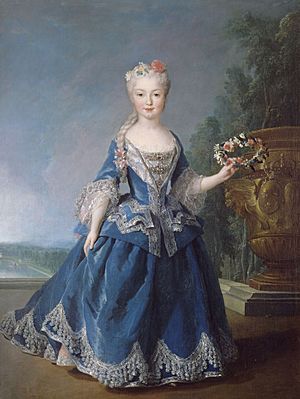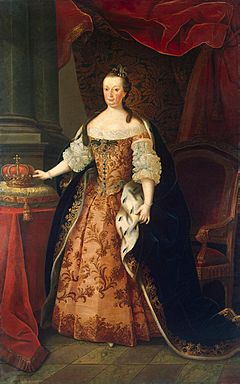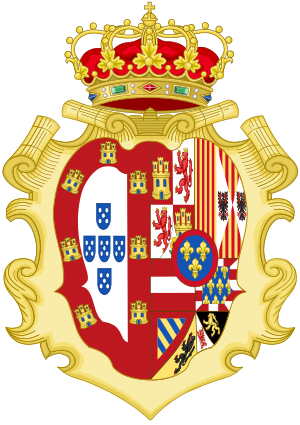Mariana Victoria of Spain facts for kids
Quick facts for kids Mariana Victoria of Spain |
|||||
|---|---|---|---|---|---|
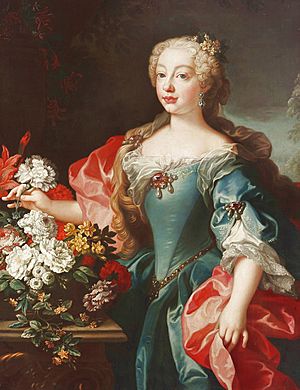
Portrait by Domenico Maria Sani at the Palace of Caserta
|
|||||
| Queen consort of Portugal | |||||
| Tenure | 31 July 1750 – 24 February 1777 | ||||
| Born | 31 March 1718 Royal Alcazar of Madrid, Madrid, Spain |
||||
| Died | 15 January 1781 (aged 62) Barraca Real of Ajuda, Lisbon, Portugal |
||||
| Burial | 17 January 1781 Pantheon of the House of Braganza, Monastery of São Vicente de Fora, Lisbon, Portugal |
||||
| Spouse | |||||
| Issue |
|
||||
|
|||||
| House | Bourbon | ||||
| Father | Philip V of Spain | ||||
| Mother | Elisabeth Farnese | ||||
| Signature | |||||
Mariana Victoria of Spain (born March 31, 1718 – died January 15, 1781) was an Infanta of Spain by birth. This means she was a princess of Spain. She later became the Queen of Portugal when she married King Joseph I.
Mariana Victoria was an important figure in Portugal. She served as a regent, which means she ruled the country for her husband, from 1776 to 1777. This happened during the last months of his life. After her husband's death, she also advised her daughter, Maria I of Portugal, who became the new queen.
Contents
Early Life of Mariana Victoria
Mariana Victoria was born in Madrid, Spain, at the Royal Alcazar of Madrid. She was named after her grandmother, Maria Anna Victoria of Bavaria. As an Infanta of Spain, she was a princess from birth.
She was the oldest daughter of Philip V of Spain and his second wife, Elisabeth Farnese. Her father was a grandson of Louis XIV of France. He became the King of Spain in 1700. When Mariana Victoria was born, she was fifth in line to the Spanish throne.
A Royal Engagement to Louis XV
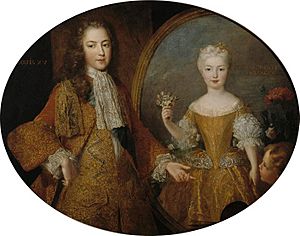
After a war, France and Spain wanted to become friends again. They decided to arrange a marriage between Mariana Victoria and her cousin, the young Louis XV of France. This plan was made by Philippe d'Orléans, who was ruling France for Louis XV.
Mariana Victoria arrived in Paris on March 2, 1722. There were many celebrations for her arrival. She lived at the Palais du Louvre. People called her the l'infante Reine, which means "Queen-Infanta." This was because she was expected to become queen when she was older.
Mariana Victoria liked Louis XV, and the court liked her. However, the king himself often avoided her. The Régent's mother, Elisabeth Charlotte of the Palatinate, said Mariana Victoria was "the sweetest and prettiest little thing." She also said Mariana Victoria was very smart for her age.
Return to Spain
Despite the plans, Mariana Victoria's stay in France did not last. On March 11, 1725, it was decided that the seven-year-old princess would be sent back to Spain. This decision was influenced by the Prime Minister, Louis Henri, Duke of Bourbon. He wanted Louis XV to marry his sister, who was older and could have children sooner.
Mariana Victoria left Versailles on April 5, 1725. Her return to Spain was seen as a big insult. It caused problems between Spain and France. Later, Louis XV married Marie Leszczyńska. To help fix relations, Mariana Victoria's sister, Infanta Maria Teresa Rafaela, married Louis XV's son in 1745.
Becoming Crown Princess of Portugal
Her return to Spain caused a diplomatic problem with France. Spain then made a treaty with Austria. Discussions for Mariana Victoria's marriage began with Kingdom of Portugal in 1727.
Another double marriage was planned. Mariana Victoria would marry Infante José, who was the "Prince of Brazil." This was the traditional title for the heir to the Portuguese throne. Her older half-brother, Ferdinand, the "Prince of Asturias" (heir to the Spanish throne), would marry José's sister, Infanta Bárbara.
Mariana Victoria married the Prince of Brazil on January 19, 1729, in Elvas, Portugal. The next day, her brother Ferdinand married Infanta Bárbara in Badajoz. From her marriage until her husband became king in 1750, she was known as the Princess of Brazil.
Mariana Victoria and Joseph had a close relationship. They both enjoyed hunting and music. Mariana Victoria was a very good singer. They supported Italian opera and theatre. During their marriage, Mariana Victoria had eight children. Four of them lived past infancy. Their first child, Infanta Maria, became the heir to her father.
Queen and Regent of Portugal
When her father-in-law, King John V, died in 1750, her husband became King Joseph I. He then ruled the large Portuguese Empire. His reign was greatly influenced by the Marquis of Pombal. Pombal was a favorite of the Queen mother.
Joseph I let Pombal manage the country. Pombal used his power to reduce the church's influence and remove his enemies. Mariana Victoria and her daughter did not like how much power Pombal had over the king.
The Lisbon Earthquake
A terrible event during her husband's reign was the 1755 Lisbon earthquake. On November 1, 1755, a huge earthquake hit Lisbon. It killed about 100,000 people. This earthquake made King Joseph I very afraid of living in buildings with walls. So, he moved the royal court to a large group of tents in the hills of Ajuda. Pombal was in charge of rebuilding Lisbon after this disaster.
The Távora Affair
In 1759, the Távora affair happened. There was an attempt to assassinate her husband. Pombal believed the powerful Távora family was responsible. He ordered the execution of many family members. Mariana Victoria and her daughter, the Princess of Brazil, stepped in. Because of them, some women and children were saved. Since Pombal was largely running the country, Mariana Victoria and her husband were less involved in politics.
Mariana Victoria as Regent
Her husband, King Joseph I, became ill after several strokes. He decided to let Mariana Victoria take his place as the head of the government. So, Mariana Victoria became the Regent of Portugal. She was made Regent on November 29, 1776. She continued to rule until her husband died on February 24, 1777.
After her husband's death, their oldest daughter became the first queen regnant of Portugal. She ruled as Maria I. Mariana Victoria had a lot of influence on her daughter during Maria I's reign. Maria I often asked her mother for advice on important state matters. Early in Maria I's reign, Pombal was sent away from the court.
Queen Dowager and Later Life
After her daughter became queen, Mariana Victoria worked to improve relations with her home country, Spain. Her older brother, Carlos III, ruled Spain at the time. The two countries had disagreements about land in the Americas.
Mariana Victoria left Portugal on October 28, 1777. She traveled to Spain and stayed for over a year. She lived in Madrid and at the Aranjuez. Mariana Victoria helped create a treaty between Portugal and Spain. This treaty was to be made stronger by two marriages between her grandchildren and Charles III's grandchildren.
While in Spain, Mariana Victoria suffered from Rheumatism. For a time in August 1778, she had to use a wheelchair. She returned to Portugal in November 1778. Her health worsened, and she was also suffering from heart disease.
Mariana Victoria died at the Real Barraca de Ajuda in Lisbon. This building is where the present Ajuda National Palace stands. She was buried at the Church of Saint Francis of Paola in Lisbon.
Legacy
Mariana Victoria was the godmother of Marie Antoinette. Marie Antoinette was born the day after the 1755 Lisbon earthquake. Mariana Victoria has many descendants today. These include the current King of Spain, King of Belgium, and Grand Duke of Luxembourg. In 1822, her great-grandson Pedro became the first emperor of Brazil.
Children
Mariana Victoria and King Joseph I had several children:
- Maria Francisca Isabel (born December 17, 1734 – died March 20, 1816): She married her uncle, Peter III of Portugal. She later became the Queen of Portugal.
- Maria Ana Francisca (born October 7, 1736 – died May 6, 1813): She was considered as a bride for the Dauphin of France. However, her mother, Mariana Victoria, did not agree to the marriage. She died unmarried.
- Stillborn daughter (February 1739).
- Maria Francisca Doroteia (born September 21, 1739 – died January 14, 1771): She was considered as a bride for Philippe Égalité. But she refused to marry him and died unmarried.
- Stillborn son (March 7, 1741).
- Stillborn son (October 15, 1742).
- Stillborn son (May 1744).
- Maria Francisca Benedita (born July 25, 1746 – died August 18, 1829): She married her nephew, Infante Joseph. They had no surviving children.
See also
 In Spanish: Mariana Victoria de Borbón para niños
In Spanish: Mariana Victoria de Borbón para niños


